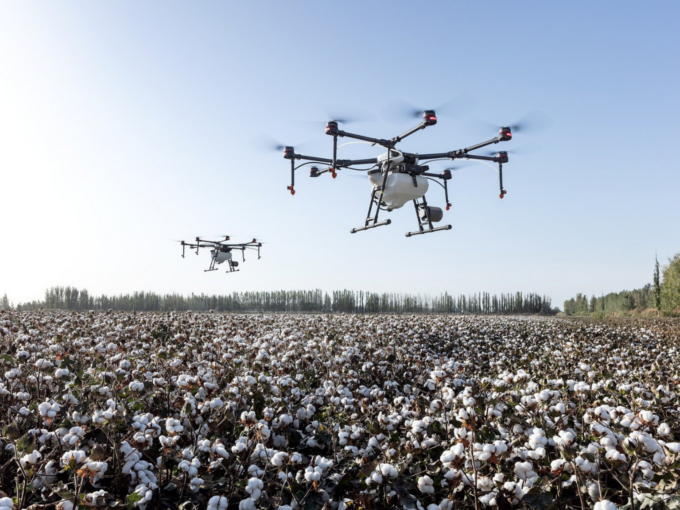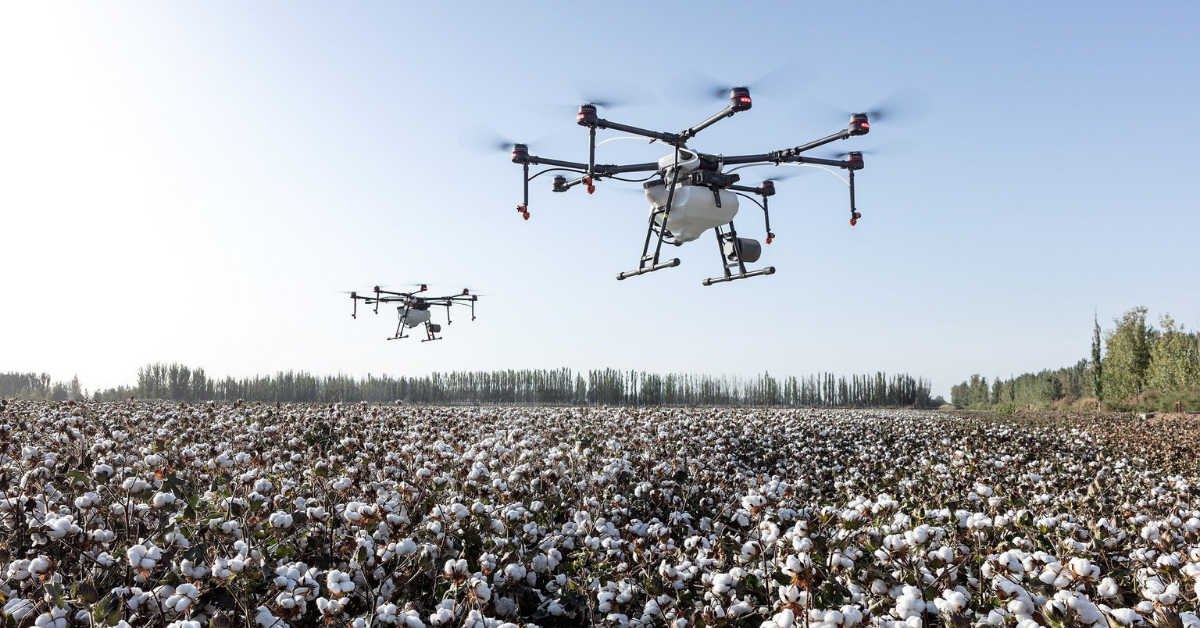In her speech, FM called on entrepreneurs to create drone-based startups, urges startups to leverage “Drone Shakti” through Drone-As-A-Service and other applications
FM says the use of ‘Kisan Drones’ to be promoted for crop assessment and digitisation of land records
Select Industrial Training Institutes (ITIs) to impart courses to students, skilling them on the know-how of the drone industry.

Delhi’s skies saw a novel treat on January 29 this year. As contingents of the Army band marched through Rajpath, it was a mesmerising sight but what held the onlooker’s gaze was the drone show afterwards.
As many as a thousand drones lit up the sky over Lutyens’ Delhi at the end of the Beating Retreat Ceremony. Dazzling in different colours, the drones shined through the evening light as did IIT-Delhi incubated startup, Botlab Dynamics, that conceptualised the show.
What was on display was the success story that is the Indian startup ecosystem. But, what many don’t remember is that barely a few years ago, flying commercial drones was illegal in India.
So, What Caused This Tectonic Shift?
On February 1, Finance Minister Nirmala Sitharaman presented the 2022 Union Budget. What was striking was that the FM, in her speech, called on the entrepreneurs to create drone-based startups. She called for leveraging “Drone Shakti” through a myriad of applications, adding that Drone-As-A-Service (DrAAS) startups were the need of the hour.
In her Budget speech, Sitharaman also said that the use of ‘Kisan drones’ will be promoted for crop assessment, digitisation of land records, and spraying of insecticides and nutrients. She also highlighted the immense potential of Geospatial Systems and Drones, saying that the sector had the power to assist sustainable development, provide employment opportunities and modernize the country.
In her speech, FM Sitharaman also announced that select Industrial Training Institutes (ITIs) would impart courses to students, skilling them in knowledge related to the drone industry.
This comes after years of bureaucratic hurdles that have essentially stifled competition in the sector. The government has, over the years, cited security issues as the reason for withholding the adoption of this futuristic technology.
A Director-General of Civil Aviation (DGCA) official had earlier told Inc42 that, “The drone regulations in India and most parts of the world are still in their nascent age. The regulatory standard still very much depends upon the presence and robustness of digital mechanisms, local threats, and most importantly the defence and offence mechanisms that are in place.”
But, as the years have passed by, the government has relented on its stance and has launched a blitzkrieg of norms to ease the adoption of drones. This all began with the issuance of The Unmanned Aircraft System Rules, 2021 in August last year. The new rules were met with mixed responses. While the strict approval norms made it tougher to acquire drone licenses, this didn’t stop drone attacks in Jammu and Kashmir and other border areas of the country.
Add to that, the UAS Rules, 2021 disappointed delivery startups that were counting on fewer regulatory norms in the guidelines to make deliveries through unmanned drones. The rules banned drones from carrying any payload, barring a few exceptions. This effectively dealt a death knell to drone-based delivery in India.
Reaffirming the Centre’s point of view, the same DGCA official had told Inc42, “Drone deliveries are thus part of this regulatory evolution and it is just that the infrastructure is not fully ready and tested yet to carry out such operations with systems in place to take on possible attacks and neutralise mishaps.”
However, the UAS Rules also lowered penalty charges and significantly eased regulations around the use of drones in India.
Building The Road Ahead
It was afterwards that the Centre went full throttle on liberalising drone usage in the country and encouraging such startups. These new rules were followed by the announcement of the INR 120 Cr Production-Linked Incentive (PLI) scheme, in September last year. The PLI scheme was envisaged with boosting domestic manufacturing of drones and drone components.
Along with the PLI scheme, the government also announced a slew of initiatives to ease the pain of the sector. In September itself, the Ministry of Civil Aviation (MoCA) had launched an interactive airspace map of India that would allow civilians to operate drones.
In addition to that, the MoCA also threw open the single-window DigitalSky platform, where applicants can easily apply for registration and operation of drones. The platform hosts airspace maps that can be used for drone navigation and for reference to zone restrictions. The beta phase of the platform was launched in 2019 but has since been panned by users for a slew of technical glitches and bad reviews.
Such was the euphoria around the new UAS Rules, 2021 that the Union Civil Aviation Minister Jyotiraditya Scindia went on record saying that the Government aimed to make India a global drone hub by 2030.
Meanwhile, even the entrepreneurs face a slew of issues with the red tape. The startups require multiple licenses, permits and approvals before they can even begin research and development on drones. Add to that, fewer green zones – areas where drones can fly freely, complicate the matters for these budding startups.
A previous Inc42 report found that a startup needs to apply for more than half-a-dozen certificates, permits and licenses, including security, insurance, landowner’s permission and so on. The applicants also need to pay a variety of specific fees that adds to the burden. All that has dimmed the outlook of an industry that is futuristic but has been left to fend for itself.
This was reflected in the dismal performance of India’s drone industry in the global race. A mere 180 drone startups are operational in the country with as much as $27 Mn being raised by these startups over the years.
But the situation appears to be changing fast. Earlier this month, MoCA notified the drone certification scheme to spur the drone manufacturing industry and make certification simpler, faster and transparent.
The guidelines set minimum safety and quality requirements to boost the manufacturing of Unmanned Aircraft Systems in the country. This will be applicable to indigenous drone manufacturers, assemblers and importers.
The implementation of the rules will be overseen by a Steering Committee chaired by a “known professional”, along with the Quality Control of India Secretariat. The single panel will ensure all issues related to the sector are resolved on an immediate basis.
Even the private sector has ramped up efforts to implement drone technology in their existing setup. Earlier, in December last year, telecom giant Reliance Jio announced that it had conducted successful trials of its connected drones on its indigenously developed 5G network.
States like Karnataka, Tamil Nadu, Rajasthan, and Punjab also began testing long-range drone deliveries on a pilot basis in June, last year. This was done to test the viability of home deliveries of medicines, ecommerce and food orders using drones.
Even the hyperlocal delivery app Dunzo too, last year, had announced plans to test drone deliveries of medicines in Telangana through a partnership with the state government and the World Economic Forum. In December, IPO-bound logistics startup Delhivery had acquired California-based drone startup Transition Robotics for an undisclosed amount.
The country faces tough competition from major players like the U.S, China and Israel. This was reflected in a July 2021 report by BIS Research that stated that the global drone market is estimated to reach $28.47 Bn in Financial Year 2021-22, with India likely to account for a meagre 4.25% share.
The Government’s intent on the industry seems to be changing. This was reflected in FM Sitharaman’s speech where the word ‘drone’ was mentioned barely 4 times. While it is a good start, the Centre needs to do much more to ensure the flow of capital into this nascent industry be it policy-wise or by creating safeguards for the sector. Otherwise, the industry will continue to be a laggard, as it is now.







![Read more about the article [Funding Galore] Over $419 Mn Raised By Indian Startups This Week](https://blog.digitalsevaa.com/wp-content/uploads/2022/02/default-social-share-image-300x158.jpg)


